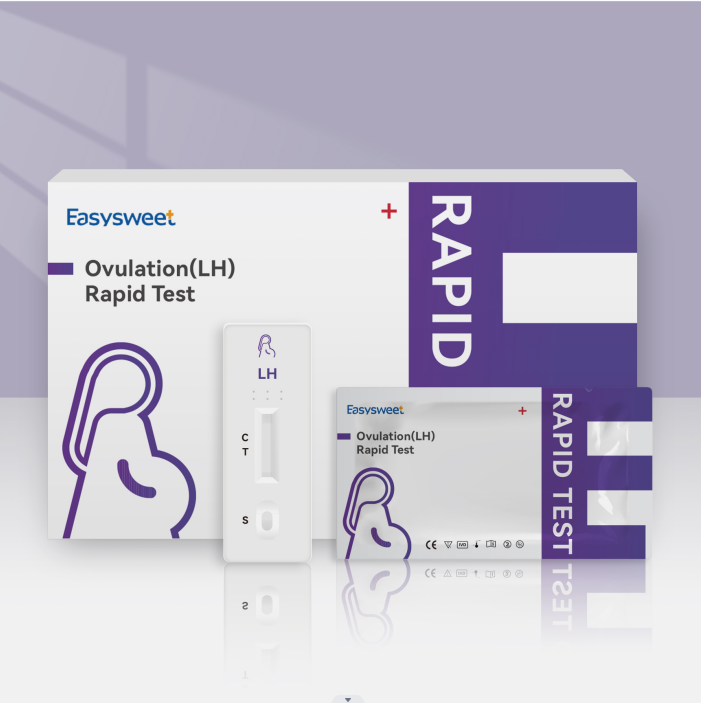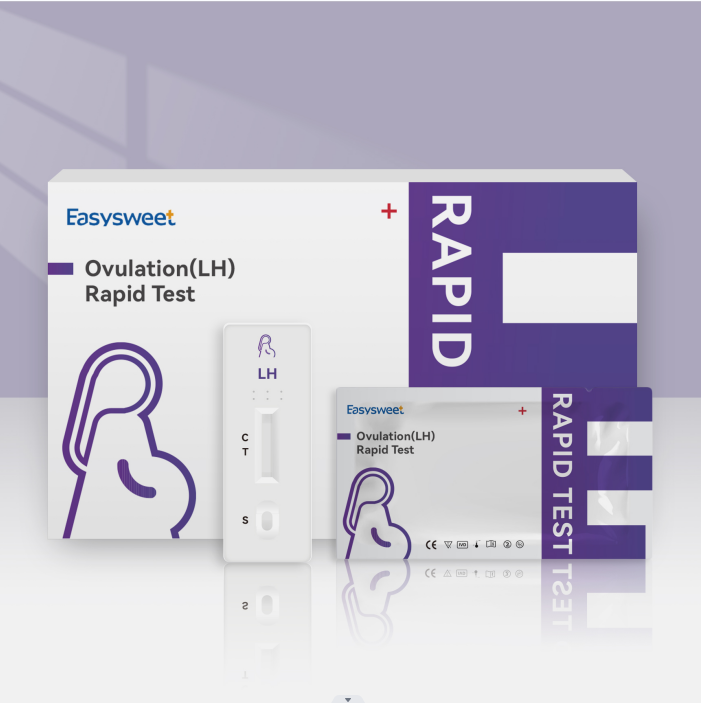Ovulation tests indicate the most fertile days of a cycle and the arrival of your next period. Ovulation occurs 10-16 days (14 days on average) before menstruation begins. If you want to predict the time of ovulation in advance, you can use the ovulation calculator to predict, and then you can use the Easysweet Ovulation test to confirm.
increase chances of pregnancy
Using the Easysweet Ovulation test to track fertile days is not a good way to prevent pregnancy. Ovulation tests can identify a LH surge 24 to 48 hours before ovulation, but sperm can survive in the body for three to five days. If sex occurs before the luteinizing hormone surge is detected by an ovulation test, the egg may still be fertilized and conception may occur.
How to Take an Ovulation Test
One way to predict ovulation is by using home tests. These tests respond to luteinizing hormone in urine, which begins to increase 24-48 hours before egg release and peaks 10-12 hours before ovulation.

Here are some Easysweet Ovulation test tips:
Testing begins a few days before ovulation is expected. Ovulation usually occurs on day 14 or 15 of a normal 28-day cycle.
Continue to take the test until the result is positive.
It is best to test twice a day. Do not take the test the first time you urinate in the morning.
Do not drink large amounts of water (this will dilute the test) before taking the test. Make sure not to urinate for about four hours before the test.
Follow the instructions exactly.
Most ovulation tests come with a booklet that can help you interpret the results. A positive result means ovulation may occur within 24-48 hours.
Measuring basal temperature and cervical mucus can also help determine the most fertile days of a cycle. A healthcare provider can also use ultrasound to track ovulation.
Ovulation tests may need to be done twice a day so you don't miss your peak
LH, detected in urine shortly before ovulation, peaks at different times and levels in different people.
Sometimes, the LH peak is brief, lasting only a few hours. To make sure you don't miss your hormonal surge, it may be helpful to take the test twice a day.
If the peak time is long (more than 24 hours), one test may be enough to indicate elevated hormone levels.
When to Start an Ovulation Test for Irregular Cycles
Ovulation tests that respond to LH are usually performed a few days before ovulation is expected.
During a standard cycle, the times will look like this:
The menstrual cycle is 28 days.
The luteal phase (from ovulation to menstruation) is fairly steady and lasts 10-16 days.
Testing begins three days before ovulation.
For a 28-day cycle, the three days before ovulation is usually around day 11 of the cycle. Do the math, starting at the end of your cycle (day 28 and the end of your luteal phase) and working backwards to the beginning. Day 1 of your cycle is the first day of your most recent period.
Irregular cycles complicate timing. For irregular cycles, your best bet is to look at the shortest cycle in the last six months. Calculations for irregular periods are generally the same as for standard periods.
For example, your minimum period is 20 days. The luteal phase lasts about 10-16 days. From the end of the cycle (day 20), minus 16 days of the luteal phase, predicted ovulation may occur on day 4. Testing begins three days before this, on the first day of the cycle.
The main reason it can be difficult to catch ovulation with irregular cycles is that it is often an indication that you may be experiencing an anovulatory cycle when you are not actually ovulating at all. If you don't detect ovulation for several cycles in a row, it's important to contact your healthcare provider to find out the underlying cause.
Are Easysweet Ovulation test results 100% accurate?
An ovulation test shows the presence of luteinizing hormone in the urine. Within 24-48 hours of the elevated levels, the follicle ruptures, the egg is released, and ovulation occurs.
However, this process sometimes fails.
There are several reasons why ovulation tests may be inaccurate.
In people with polycystic ovaries, tests may show a surge in luteinizing hormone, but ovulation may not have occurred.
As unruptured follicles luteinize, LH levels are high enough to be detected by tests, but the eggs do not leave the ovaries.
If the hypothalamus is abnormal, the production of luteinizing hormone can malfunction. Hormone levels may be high, but ovulation does not occur.
To determine when ovulation is approaching, it's best to use a combination of methods. Ovulation tests are done, basal body temperature is measured, and changes in cervical mucus are monitored.
Test strips vary in sensitivity, measured in international units per liter (IU/L). This parameter represents the minimum amount of luteinizing hormone (from 10 to 40 IU/L) that the test can detect in urine.
A high sensitivity test (10 IU/L) is more likely to detect elevated LH levels, even if the peak is low.
Some test systems also show an estrogen surge, which precedes a rise in luteinizing hormone. This helps determine the start of the fertile window earlier than a LH test alone.
Positive Easysweet Ovulation test: What to do next
A positive test result indicates a surge in luteinizing hormone, and ovulation should occur within the next 24 to 48 hours. However, this is not the case for everyone. In some cases, there may be other possible causes of elevated LH levels and false positive tests, such as PCOS, luteinized unruptured follicles, pituitary disease, perimenopause, or menopause.
A positive ovulation test represents the best chance of pregnancy. If you are unsure of the results, read the leaflet that came with your ovulation kit.
Negative ovulation test strips: everything done right?
A negative ovulation test means there was no luteinizing hormone surge and ovulation did not occur. If you are unsure about the results, check the booklet that came with the test.
Some of the content of the article comes from the Internet, if there is infringement, please contact us.


